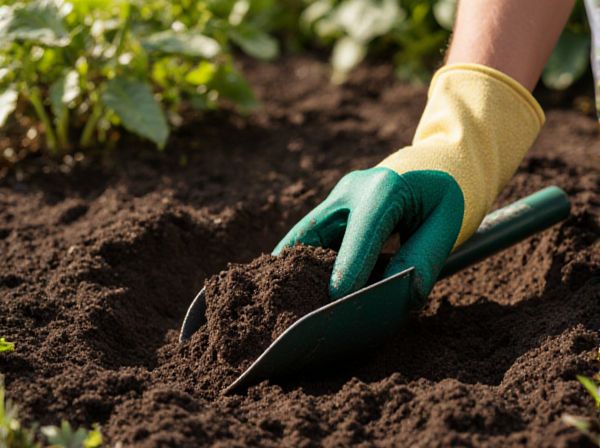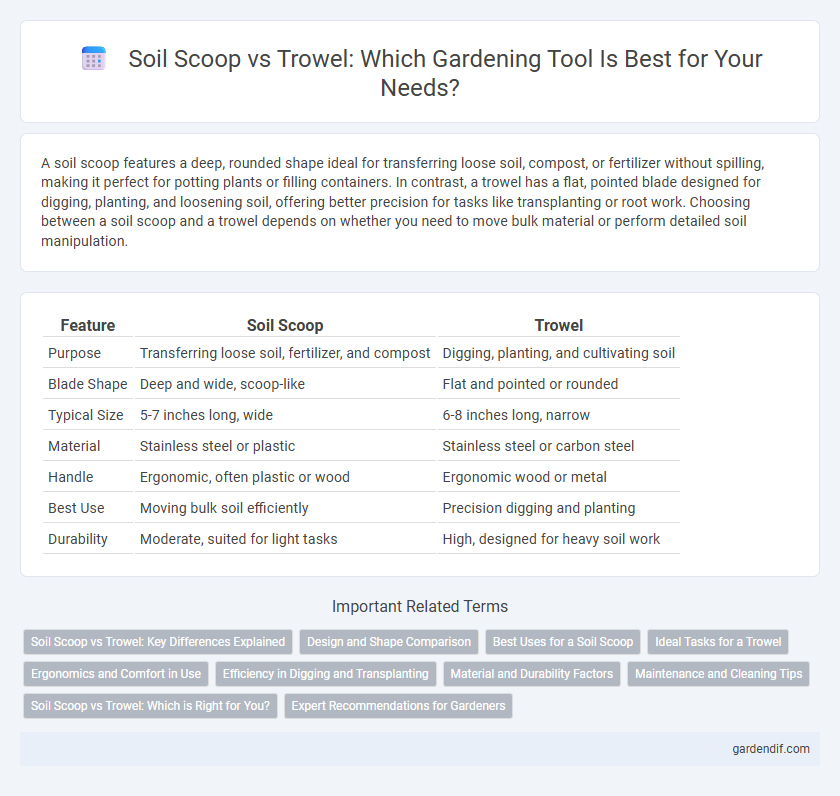
Soil scoop vs trowel Illustration
A soil scoop features a deep, rounded shape ideal for transferring loose soil, compost, or fertilizer without spilling, making it perfect for potting plants or filling containers. In contrast, a trowel has a flat, pointed blade designed for digging, planting, and loosening soil, offering better precision for tasks like transplanting or root work. Choosing between a soil scoop and a trowel depends on whether you need to move bulk material or perform detailed soil manipulation.
Table of Comparison
| Feature | Soil Scoop | Trowel |
|---|---|---|
| Purpose | Transferring loose soil, fertilizer, and compost | Digging, planting, and cultivating soil |
| Blade Shape | Deep and wide, scoop-like | Flat and pointed or rounded |
| Typical Size | 5-7 inches long, wide | 6-8 inches long, narrow |
| Material | Stainless steel or plastic | Stainless steel or carbon steel |
| Handle | Ergonomic, often plastic or wood | Ergonomic wood or metal |
| Best Use | Moving bulk soil efficiently | Precision digging and planting |
| Durability | Moderate, suited for light tasks | High, designed for heavy soil work |
Soil Scoop vs Trowel: Key Differences Explained
A soil scoop features a deep, rounded shape ideal for moving loose soil and transferring compost efficiently, whereas a trowel has a narrow, flat blade designed for digging, planting, and precision work in tight spaces. The soil scoop's larger capacity makes it perfect for scooping bulk materials, while the trowel excels in detailed tasks such as transplanting seedlings and weeding. Choosing between a soil scoop and a trowel depends on whether your gardening requires bulk material handling or fine, delicate soil manipulation.
Design and Shape Comparison
A soil scoop features a deep, rounded bucket with raised edges designed for efficiently transferring loose soil or compost, while a trowel typically has a flat, pointed blade suited for digging, planting, and precision work in confined spaces. The soil scoop's broader, concave shape allows for larger volume handling, contrasting with the trowel's narrower, tapered design that enhances control and penetration in compact soil. Ergonomic handles on both tools improve grip, but the trowel often includes markings on the blade for measuring planting depth.
Best Uses for a Soil Scoop
A soil scoop excels at digging, transferring, and bulk handling of soil, compost, and mulch due to its deep, rounded shape and sturdy build. It is ideal for filling pots, seed trays, and small containers quickly, especially when working with loose or granular materials. Unlike a trowel, which is better suited for precise planting and digging, the soil scoop's design maximizes efficiency in heavy-duty gardening tasks and large-volume soil management.
Ideal Tasks for a Trowel
A trowel is ideal for precision gardening tasks such as transplanting seedlings, breaking up soil clumps, and digging small holes for bulbs or plants. Its narrow, pointed blade allows for accurate soil manipulation in confined spaces, making it essential for container gardening and detailed flowerbed work. Compared to a soil scoop, the trowel excels in tasks requiring control and delicacy.
Ergonomics and Comfort in Use
Soil scoops feature ergonomic handles designed to reduce wrist strain during extended use, making them ideal for heavy-duty soil movement. In contrast, trowels typically have smaller, straight handles that may cause discomfort with prolonged digging or planting in dense soil. Choosing a soil scoop or trowel depends on hand size and task duration, with ergonomic designs significantly enhancing user comfort and reducing fatigue.
Efficiency in Digging and Transplanting
Soil scoops offer greater efficiency in digging and transplanting by providing a deeper, curved blade designed to move larger volumes of soil quickly. Trowels excel in precision and control for delicate transplanting tasks due to their smaller, flatter blade and pointed tip. Choosing between a soil scoop and a trowel depends on the specific gardening task, balancing bulk soil movement with detailed root handling.
Material and Durability Factors
Soil scoops are typically made from heavy-duty stainless steel or reinforced plastic, offering superior durability for handling dense soil and rocks, while trowels often use lighter materials like aluminum or carbon steel that may wear faster under tough conditions. The robust construction of soil scoops enhances resistance to bending and corrosion, making them ideal for long-term use in harsh environments compared to the more delicate trowel blades. Choosing between these tools depends on the soil type and required resilience, with soil scoops suited for heavy-duty digging and trowels for precision planting and transplanting.
Maintenance and Cleaning Tips
Soil scoops require regular cleaning to prevent soil buildup, using a stiff brush and warm soapy water to maintain rust resistance. Trowels should be wiped clean after each use and occasionally oiled to protect the metal blade from corrosion. Proper maintenance of both tools extends their durability and ensures efficient performance during gardening tasks.
Soil Scoop vs Trowel: Which is Right for You?
Soil scoops feature a deeper, curved blade designed for efficient digging and transferring soil, making them ideal for gardening tasks that require moving larger amounts of soil quickly. Trowels have a flatter, narrower blade suited for precision tasks like planting small seedlings or working in tight spaces. Choosing between a soil scoop and a trowel depends on your gardening needs: scoops excel in bulk soil handling while trowels provide more control for detailed planting and weeding.
Expert Recommendations for Gardeners
Experts recommend choosing a soil scoop for handling loose, granular materials such as potting mix or compost due to its deep, rounded shape that maximizes material retention and reduces spillage. For precise planting and transplanting tasks, a trowel is preferred because of its narrow, pointed blade that allows accurate digging and root placement in confined spaces. Gardeners benefit from having both tools in their collection to optimize efficiency and effectiveness across various soil manipulation activities.
Soil scoop vs trowel Infographic

 gardendif.com
gardendif.com